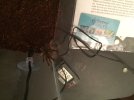Hello,
I'm requiring some advice. I'm new to just recently buying my tarantula. She is a year and a half old and she is an Australian desert tarantula (phlogius sp). She is in a decent size enclosure not too big.. I put her in yesterday for the time but all she has done so far is just sit in the corner of her enclosure where the heat mat is located. I understand she hasnt settled properly yet But should I be worried or is there anything I can be doing? I'm hoping she will move under the skull to create a home. Any help would be really appreciated.
I'm requiring some advice. I'm new to just recently buying my tarantula. She is a year and a half old and she is an Australian desert tarantula (phlogius sp). She is in a decent size enclosure not too big.. I put her in yesterday for the time but all she has done so far is just sit in the corner of her enclosure where the heat mat is located. I understand she hasnt settled properly yet But should I be worried or is there anything I can be doing? I'm hoping she will move under the skull to create a home. Any help would be really appreciated.



